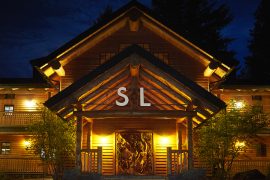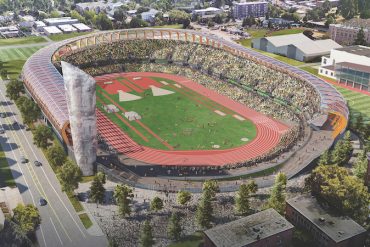All the things I’ve missed by driving this route are now gliding by in new context. There are loading docks for staging wheat, stone and lumber bound for Japan by way of the Port of Portland. There are stacked pallets, the underpinnings of economic growth. There are long-necked conveyor belts drawing grains from trucks and depositing them up and into railcars, like brontosauruses that modernity forgot.
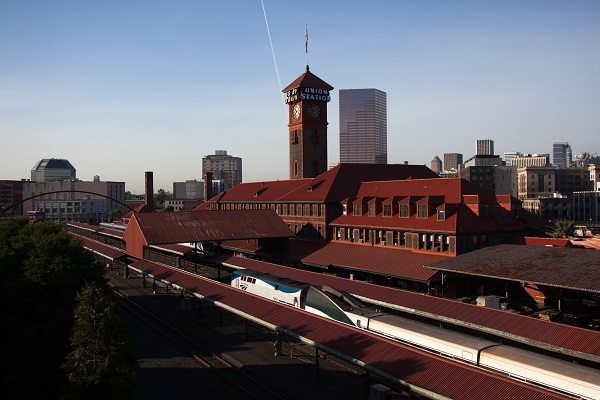
by Tim LaBarge
As the Amtrak Cascades 508 pulls out of Eugene, the yards of steel railcars give way to fields of wheat in spring green color. Warehouses become dirty old doghouses and then farmhouses. A covey of birds sits on the power line overlooking sheep, goats, cows and a llama.
Train travel had once been a regular part of my life more than a decade ago in New York. There was the F or D subway line from Brooklyn to Midtown for work and then the Ethan Allen Express from Penn Station to long weekends in Vermont. Undeveloped open areas and the minivan had become the new reality in Oregon. From Bend, it’s also difficult to catch a train, legally.
Nevertheless, we are creatures of nostalgia, and it was National Train Day. We were already a few hours into a train trip that would encompass a Van Gogh at Jordan Schnitzer Museum of Art in Eugene, a Venetian exhibit at the Portland Art Museum, a Portland Thorns game, and Italian and Indian food. First, though, we had time to reconnect on the Amtrak Cascades line from Eugene to Portland.
Though the same distance can be equally achieved in a car, highway travel is a completely different experience. Because this train is, essentially, new and its service along the route expanded, we might better deem this piece “Rail Considered” on the first pass.
After reading an article in The New York Times one recent Sunday that said that top art collectors often send their new acquisitions to venues in five states, including Oregon, on a short-term loan as part of a legal tax-evasion program, I, a couple tax brackets closer to earth, wanted to take cultural advantage of that phenomenon before these pieces went back to their tax-advantaged havens elsewhere.

by Tim LaBarge
The full Amtrak Cascades line begins in Eugene and terminates in Vancouver, British Columbia with sixteen stops—most of them in Washington. Four of these, however, are at depots in the Oregon towns of Albany, Salem, Oregon City and Portland.
Before embarking in Eugene, we headed to the Jordan Schnitzer Museum of Art on the campus of the University of Oregon, where a couple of exhibits drew our attention—an entertaining contemporary collection from Royal Bank of Canada Wealth Management and “L’Homme est en Mer” by Vincent Van Gogh. This chilling piece was painted by Van Gogh in 1889 after he cut off his ear and checked himself into a mental institution. Its past owners include actor Errol Flynn and the heir to the Campbell Soup Company fortune, John T. Dorrance, whose net worth at the time of his death in 1930 was calculated to be equivalent to 1/786th of the gross domestic product of the United States.
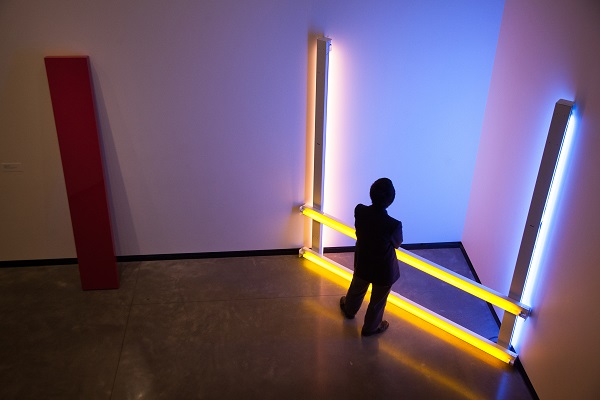
by Tim LaBarge
The painting of the woman and infant waiting for the father to return from sea was projected to fetch $17 million at a Sotheby’s auction in February, but things got a little out of hand. The final sale came in at $27.5 million in what would be a record-breaking day for art sales at the London auction house. Scandalous prices make for better viewing.
Perhaps one of the best things about taking the train is its interface with train depots. The older, the better. If they’re new, then they’d better at least take after their predecessors.
In the case of the Eugene station, the building looks fairly new, but it feels like a piece of history. This Craftsman-style building is a nod to nineteenth-century architect Henry Hobson Richardson of Harvard College and Tulane University, who became the second American to study architecture at École des Beaux-Arts in Paris. He later built Trinity Church in Boston then studied in Japan, where he was influenced by pitched roofs and deep eaves.
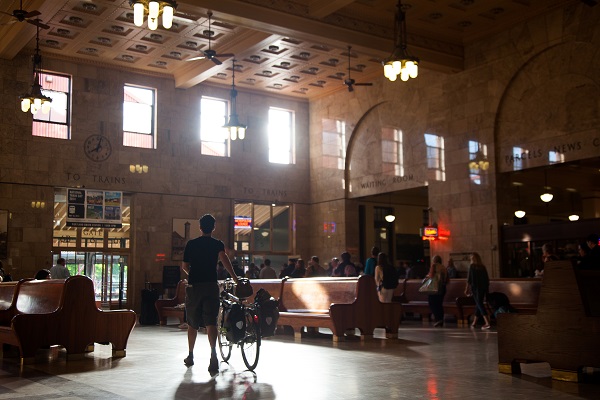
by Tim LaBarge
The 508 pulls out of this depot promptly at 4 p.m. on Fridays. Most of the riders are students from University of Oregon headed home for the weekend or into Portland for a show. There are young families with toddlers and a few older folks who would rather not drive on a Friday evening. Maybe it’s the recent universal fondness for and obsession with mobile phones, but the train is much more subdued and quiet than I remember. Over the intercom, the conductor reminds passengers to abscond to the space between railcars if they want to talk on their phones.
Most talking, these days, is texting, and most texting is quiet, so quietly we go.
There are refineries, rivers, irrigation canals, ball fields, gardens, farms, tractors, silos, hay barns and more pallets, railroad ties, I-beams, shacks and dilapidated houses, hen houses, corrugated metal storage sheds. All the things I’ve previously missed along the way.
A little more than forty minutes later, we pull into the Albany station. It’s another beautiful restoration of turn-of-the-century masonry designed for the Southern Pacific Railroad in 1909. If we had time or a layover, we would happily jump off here and make the fifteen-minute walk to Sybaris Bistro, where chef Matt Bennett creates innovative and classic cuisine.
About half an hour up the tracks, a stylish and tall blonde waits in the rain, eager for our arrival. The striking yellow-brick Salem Station is a Beaux-Arts standout that would stand comfortably next to the Grand Palais in Paris. The Art Déco state capitol, just blocks away, provides as much architectural clash as the haunting metro signs do for Paris. One Art Déco spot worth the detour is the new Maven modern bistro on State Street, a short walk downtown from the station.
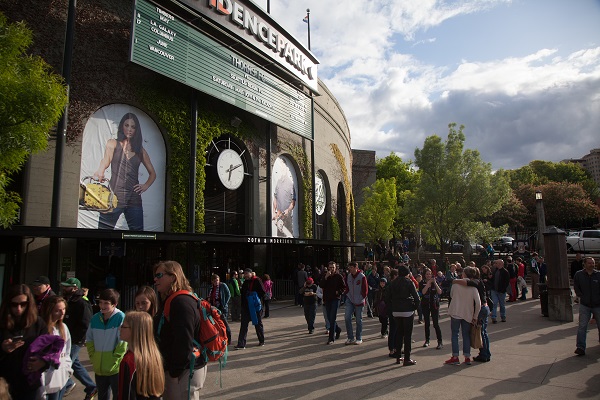
by Tim LaBarge
Almost two-and-a-half hours to the minute, Amtrak Cascades 508 crosses the historic Steel Bridge straddling the Willamette River. Cranes on South Waterfront, the new Tilikum Crossing bridge, graffiti under older bridges, biking paths over bridges and bikers in yellow suits heading east over the bridge—all are indicators that we have arrived in Bridgetown.
The clock tower of the station rises into a sprinkling of rain, through wan beams of sunlight. From its perch there, 150 feet above the river, a neon message from 1948 implores us to “Go by Train,” a journey we’re just beginning.

by Tim LaBarge
We’ll travel a little further back in time through the lens of Portland Art Museum’s exhibit on Venetian art and music. In its best incarnation, a soccer game, such as that put on by the Portland Thorns, can be a work of public art, too. In this exhibition, the Seattle Reign was, however, slightly more artful in a one-nil victory. A stop at the Thorns apparel stand helps my pre-teen, soccer fanatic daughters forget the score.
In our larger “Go by Train” journey through time, art, architectural eras and sports apparel, this loss will soon be history.

by Tim LaBarge
1. |
Quick Take |
2. |
Eugene and Portland Art |
3. |
Stay and Play |
4. |
Portland Thorns or Timbers |
Rail Stats
424 |
Rail miles from Eugene to Vancouver, B.C. |
18 |
Number of stops on the Amtrak Cascades line. |
6 |
Number of major art museums along the Amtrak Cascades line. |
2 |
Number of new trains Oregon bought to serve this line. |


